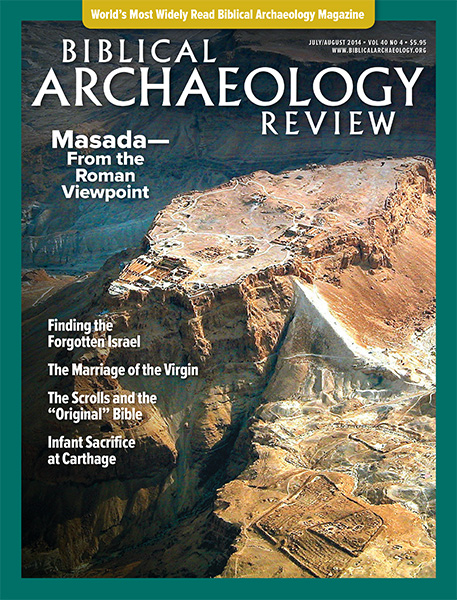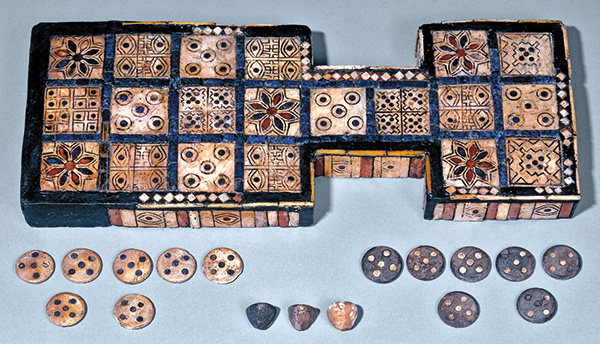Queries & Comments

008
Covenant of Salt
In your May/June issue (Queries & Comments, “Salting Newborns”), a reader asks why newborn babies were sprinkled with salt, referring to Ezekiel 16:4: “On that day you were born … You were not rubbed with salt.” Salt is a preservative and represents endurance in the Bible, as is indicated in the expression “covenant of salt.” Israel had an enduring covenant of salt with the Lord (see Leviticus 2:13; Numbers 18:19; 2 Chronicles 13:5). So, too, salt was applied to a newborn in the hope of an enduring, long life.
New Rochelle, NY
Mount Sinai
Ten Commandments or Tic-Tac-Toe?


We see what we want to see: The drawing of the great Decalogue at what might be Mount Sinai (see Hershel Shanks, “Where Is Mount Sinai?” BAR 40:02 and Queries and Comments, “Meaning of Rock Drawings,” BAR 40:04) is in reality the game board for the Royal Game of Ura. This was a prophecy device that was also the most famous tic-tac-toe plan of ancient times.
Kissimmee, Florida
Setting Sun Points to Real Mt. Sinai?
In the summer of 1978 when I was 35 years old, I was a volunteer on an excavation in Israel. We also toured the Sinai desert (when the Israelis still controlled it). We spent one night at the foot of the traditional Mt. Sinai and then climbed it in the dark to observe sunrise from the top. During the period of sunset, the rays of the setting sun make the peak of Mt. Sinai glow red as the shadow of night gradually ascends the peak, until the last rays make the very top of the mountain glow brilliantly against the darkening sky. Observing that, it is not at all hard to see why people in antiquity (and now) would see that peak as very special. The phenomenon is due to valleys directly west of Mt. Sinai allowing the sun to shine on that single peak while the surrounding peaks are already dark. It is just the sun’s rays on pink granite, but it is awesome whether or not it is the “real” Mt. Sinai.
St. Paul, Minnesota
Original Bible
Did God Work on the Sabbath?
In “Searching for the ‘Original’ Bible” (BAR 40:04), Emanuel Tov raises the question as to whether God worked on the seventh day. He suggests the question is somewhat different in two different text-types illustrated in the Dead Sea Scroll texts.
There is, however, a conceptual third answer to the question of whether God “worked” on the seventh day. The “right” answer need not be a clear “yes” or “no.” In his classic book The Sabbath, Rabbi Abraham Joshua Heschel quotes from the Evening Service for the Sabbath: “Last in creation, first in intention” the Sabbath is “the end of the creation of heaven and earth.” Then Heschel adds: “Three acts of God denoted the 009 010 seventh day: He rested, He blessed, and He hallowed the day.” God did indeed create on the Sabbath, but what was created was not physical, rather it was “holy time,” the Sabbath itself. If one follows Rabbi Heschel’s train of thought, all of the early texts are accurate, since God not only created the Sabbath but also rested in his final act of creation.
New York, New York
The Masada Siege
Did Herod or the Romans Do It?
Re: “The Masada Siege—From the Roman Viewpoint” by Gwyn Davies (BAR 40:04).
How do we know that the additions to the “siege” ramp were built by the Roman besiegers rather than by King Herod’s own builders when they developed the complex at Masada? How could Herod’s builders lift the materials and water up to the top of Masada without building such a ramp as part of this fortress-palace?
Berwyn, Illinois
Gold from the Temple
Why Would a Forger Do It?
Re: the Yehoash Tablet (First Person, “Gold from the Temple,” BAR 40:04).
I cannot imagine why a forger would contaminate his work with gold micro-particles.
However, if a forger wanted them, they are indeed available commercially from a number of sources. They are used as markers in electron microscopy and have many applications in biomedicine.
Gold microparticles were also used in Roman glass manufacturing to make red and dichroic glass which has a different color when seen by reflected and transmitted light. The principle seems to have been known also to medieval stained glass artisans and is now used to make cranberry glass. It is unclear as to how the gold was incorporated into Roman glass—only tiny amounts are necessary, and modern methods for production of gold microparticles are complicated.
Based on pure speculation, I would go with the street talk mentioned by the author: Gold contaminates silver, so the source need not have been pure gold 063 vessels. The airstream produced in a major conflagration might have carried vaporized gold and dispersed it as spheres. On the other hand, a forger’s patination process might well have involved material heated to high temperatures leaving behind a particulate residue of a contaminant. Personally, I would rather think the Yehoash inscription authentic, but one still has to wonder.
As always BAR makes me think!
Department of Pathology and Laboratory Medicine
University of North Carolina School of Medicine
Chapel Hill, North Carolina
Marriage of the Virgin
Art Historians as Archaeologists
As an art educator teaching the history of Western art to both high school and college students, I happily devoured Theodore Feder’s analytical discussion of Campin’s Marriage of the Virgin (“Parsing ‘The Parting’ Painting,” BAR 40:04).
I find that students today are often loath to spend the requisite time and effort to “dig” beneath the visual substance of a work of art for the context and intent of the artist. Serious students of art history, avidly curious to discover the secrets hidden beneath the layers of conjecture and mystery surrounding early works of art, are really “armchair archaeologists,” searching for traces of our past and evidences of our humanity.
Bravo, BAR, for sharing with us, your more “visual learners,” this gem of a painting to further inform and pique our interest in the link between Judaism and the early Christian canon.
Mount Dora, Florida
Corrections
In “Searching for the ‘Original’ Bible” by Emanuel Tov (BAR 40:04), two 064 Hebrew terms were inadvertently interchanged. The sentence involved should have read: “I believe the Masoretic Text was textually corrupted when the continuous writing (without spaces between words) of the original words pr mshlsh (“three-year-old bull”) underlying the Septuagint was divided wrongly to prm/shlshh (literally: “bulls three”).”
And in the following paragraph, quoting Genesis 15:9, the animal mentioned is “a heifer of three years old” [
The Israel Numismatic Review is published by the Israel Numismatic Society (not the Hebrew University as we stated in Strata, “The Other Side of the Coin,” BAR 40:04).—Ed.
Covenant of Salt
You have already read your free article for this month. Please join the BAS Library or become an All Access member of BAS to gain full access to this article and so much more.
